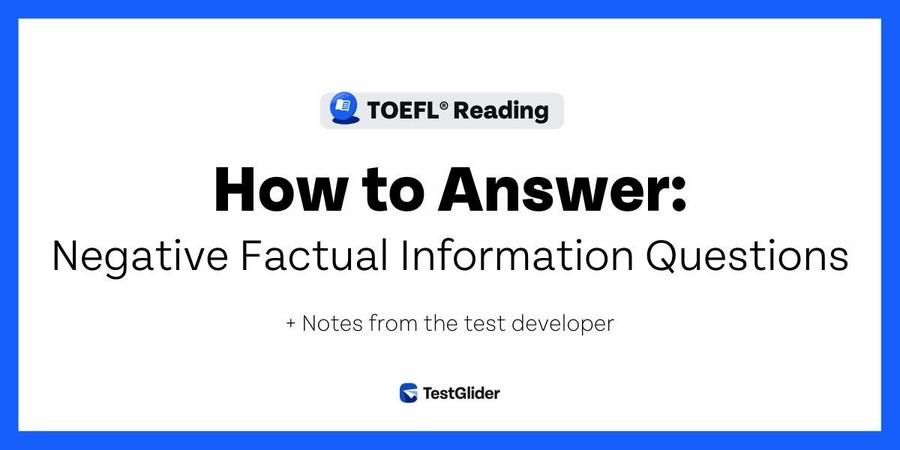Let’s learn how the TOEFL Reading negative factual information questions are made and how to choose the correct answer every time.
This post is part of a “How to Answer” series brought to you by our TOEFL test developer [TG_John] from the TestGlider team.
Information about Negative Factual Information Questions
Negative Factual information questions are very similar to Factual Information questions except that they are asking the test taker to do the opposite thing. Instead of choosing the one answer that is correct, they must select the answer that is incorrect. They are often more difficult to answer than Factual Information questions.
Three of the four options will be correct, but one will contain information that is incorrectly stated or was not included in the passage. They are easy to recognize because the question will always contain the words “EXCEPT” or “NOT”. Such questions may be written the following ways:
- According to paragraph 1, which of the following is NOT true of/about X ?
- According to paragraph 1, all of the following are true about X EXCEPT …
- All of the following are mentioned in paragraph 1 about X EXCEPT …
TOEFL Reading Negative Factual Information Question Example
Here is an excerpt from a passage and its Negative Factual Information question:
“Insulin is a hormone secreted by the pancreas that regulates the absorption of glucose into the body. The inability to generate or respond properly to insulin causes symptoms like increased thirst and appetite and frequent urination, which are commonly associated with a group of metabolic disorders called Diabetes mellitus. Without proper treatment, diabetes can result in cardiovascular disease, foot ulcers, damage to the nervous system, and death. Type 1 diabetes is caused by the pancreas’s inability to produce sufficient insulin and must be treated with injections of insulin. Type 2 diabetes results from cells being unable to respond properly to insulin, and may be treated by carefully controlling diet and exercising or taking oral medication. Gestational diabetes occurs in some pregnant women, but it usually resolves itself after they give birth. 436 million people suffer from diabetes worldwide, and 10 percent of cases are Type 1 diabetes.”
Question :
According to paragraph 1, which of the following is NOT true about insulin?
(A) Patients with Type 1 diabetes must receive intravenous insulin to compensate for their insufficient supply.
(B) Insulin is generated by the pancreas and controls cellular ingestion of glucose.
(C) Some pregnant women have temporary diabetes because they cannot generate enough insulin for their baby and themselves.
(D) A lack of insulin causes people to experience extreme thirst and hunger and increased urination.
Explanation :
The correct answer is (C). Gestational diabetes is a temporary condition, but the passage does not say that it is caused by the mother’s inability to generate enough insulin for the baby and herself. (A) is a restatement of the fourth sentence in paragraph 1. (B) is a restatement of the first sentence in paragraph 1. (D) is a restatement of the second sentence in paragraph 1.
Notes from the Test Developer
TOEFL Reading Negative Factual Information questions are less common than Factual Information questions in TOEFL RC passages, but there are often 1 or 2 per passage. Like the Factual Information questions, there is a lot of variety in how the questions and answers are written. The distractors are much easier to write, because they are literal paraphrasing of the sentences in the passage, although some incorporate information from more than one source sentence.
The correct (or in this case incorrect) answer choice may be a clearly false statement based upon the information presented in the passage. There are also (in)correct answers that state factually correct information that is not mentioned in the passage. Others state unmentioned information that sounds like it could be accurate but is not. Some make statements that can be inferred from the information presented in the passage but are not directly stated, which makes them (in)correct for this type of question.
The correct answer in the example is the final type. It is logical to infer that gestational diabetes is caused by the mother’s inability to produce enough insulin for the baby and herself, but that information is not included in the passage, so it is wrong.
Advice to Test Takers
The TOEFL Reading section frequently includes Negative Factual Information Questions, which test your ability to identify information that is NOT mentioned in the passage. Success in these questions requires not only careful reading comprehension but also the skill to detect subtle differences between the passage content and answer choices.
Core Principles:
- The correct answer must contain information NOT mentioned in the passage
- A correct answer may include accurate details but make incorrect assertions about them
Step-by-Step Approach:
- Read the passage carefully
- Examine each answer choice thoroughly
- Identify options containing unfamiliar information
- Verify that this information is truly absent from the text
Time Management & Key Tips:
- Make educated guesses when uncertain – there’s no penalty for wrong answers
- Watch for contradictory statements and altered cause-effect relationships
- Be cautious of absolute terms (always, never, must)
- Remember that all options may sound partially correct
Being methodical often trumps being fast. Verify when possible, but don’t hesitate to make educated guesses when needed.
🎯 Ready to Master TOEFL Reading ?
Take TestGlider’s FREE TOEFL Practice Test and assess your current reading level. Join thousands of test-takers who’ve improved their scores through our comprehensive practice materials.
